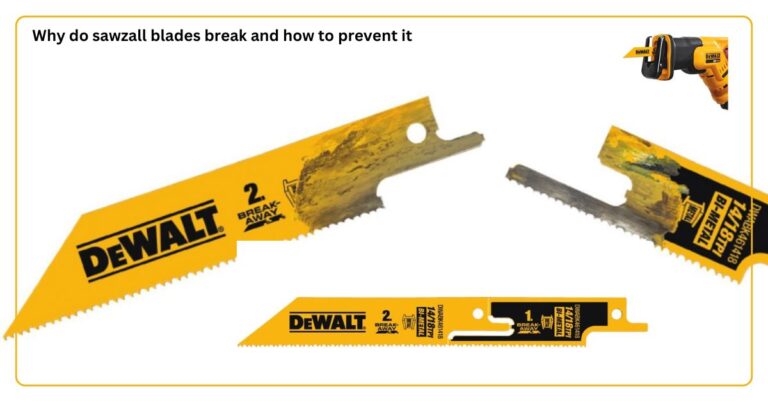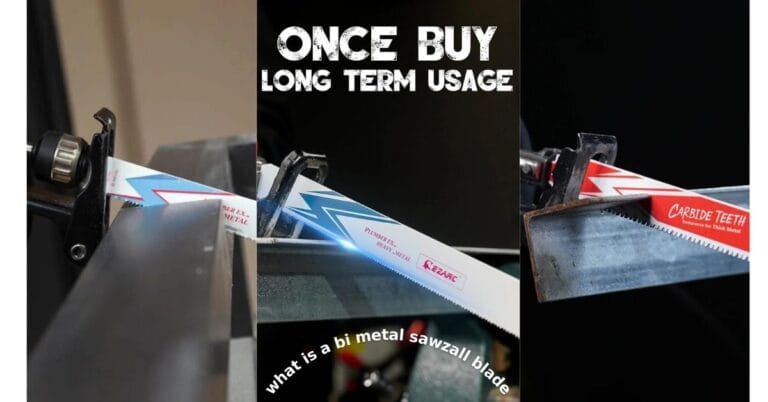Yes, Sawzall blades can work effectively on fiberglass, but you’ll need the right type of blade and proper cutting technique. This guide covers everything you should know about cutting fiberglass with a reciprocating saw.
Matching Blade to Fiberglass Thickness
Understanding what TPI means on a Sawzall blade, and why it matters, is key here; TPI (Teeth Per Inch) determines how fine or rough your cut will be, which directly affects fraying and smoothness when working with fiberglass.
|
Fiberglass Thickness |
Recommended Blade |
TPI Range |
|---|---|---|
|
Thin (similar to sheet metal) |
Bi-metal, higher TPI |
18-24 TPI |
|
Medium (boat hulls, panels) |
Carbide-grit |
14-18 TPI |
|
Thick (automotive hardtops) |
Longer carbide blades |
10-14 TPI |
- Always wear protective gear. Fiberglass dust and particles can irritate your skin, eyes, and lungs.
- Run your reciprocating saw at slower speeds to avoid heat buildup that can melt the resin.
- Support the fiberglass securely to reduce vibration and prevent cracks during cutting.
Let the Sawzall blade do the work. Too much pressure can cause binding or uneven cuts. - Mark your cutting lines clearly for accuracy, especially when splitting larger fiberglass panels or components in half.
5 Tips for Clean Fiberglass Cuts
- Wear protective gear. Fiberglass dust can irritate your skin, eyes, and lungs, so use gloves, safety glasses, and a respirator.
- Use slower speeds on your reciprocating saw to prevent heat buildup that can melt the resin and damage the material.
- Support the fiberglass securely to minimize vibration and avoid cracking during the cut.
- Let the Sawzall blade do the cutting. Applying too much pressure can cause binding and rough edges. This is exactly why using the right blade is efficient and time-saving; it minimizes effort, extends blade life, and prevents unnecessary mistakes.”
- Mark your cutting lines clearly for precision, especially when trimming or cutting larger fiberglass components in half.
Common Problems and Solutions
Another common issue is blade snapping. Many wonder why Sawzall blades break and how to prevent it; the main causes are excessive pressure, wrong blade choice, and poor support of the material. Sticking to proper cutting speeds and matching blade type to thickness reduces the risk.
| Problem | Solution |
| Excessive fraying | Use higher TPI or apply masking tape along the cut line |
| Blade dulling quickly | Invest in quality carbide blades |
| Melting resin | Reduce cutting speed and take cooling breaks |
Proper Waste Disposal
- Collect all fiberglass dust and scraps in sealed, heavy-duty bags to prevent particles from spreading.
- Never dispose of fiberglass waste illegally it can harm the environment and may lead to fines.
- Check your local waste management or recycling facility guidelines to ensure proper and safe disposal of fiberglass materials.
Conclusion
The right Sawzall blade can make all the difference when cutting fiberglass. For the cleanest results, choose a carbide-grit blade or a high-TPI bi-metal blade that matches your material thickness. Whether you’re tackling boat repairs, automotive fiberglass panels, or cutting fiberglass sheets, selecting the correct blade length and TPI (Teeth Per Inch) will deliver smooth, efficient cuts while reducing tool wear.
Some users also wonder if Sawzall blades are universal or interchangeable; the good news is that most reciprocating saws accept standard blades, but you’ll still need to choose the right blade design for fiberglass.
Frequently Asked Questions
Can I use a Sawzall to cut fiberglass?
Yes, a Sawzall (reciprocating saw) can cut fiberglass effectively if you use the right blade, such as carbide-grit blades or bi-metal blades with a high TPI (Teeth Per Inch) rating.
What type of Sawzall blade is best for fiberglass?
For the cleanest cuts with minimal fraying, use a carbide-grit blade. If you want a more budget-friendly option, choose a bi-metal blade with 14–18 TPI.
What blade length should I use for cutting fiberglass?
Blade length should match your material thickness: 6–9 inches for thin fiberglass sheets and 9–12 inches for thicker components like automotive hardtops or boat panels.
How can I avoid fraying or cracking fiberglass while cutting?
Use slower cutting speeds, support the material to prevent vibration, and let the blade do the work without applying too much pressure.
What safety precautions should I take when cutting fiberglass?
Wear protective gloves, safety goggles, and a respirator to protect against fiberglass dust and particles, which can irritate the skin, eyes, and lungs.
How do I properly dispose of fiberglass waste?
Collect all dust and scraps in sealed bags and follow your local waste facility guidelines for safe and legal disposal.
Can I use the same Sawzall blade for both fiberglass and other materials?
Some bi-metal blades can handle both fiberglass and softer materials like wood or plastic, but for the best results and blade life, use a blade designed specifically for fiberglass.






